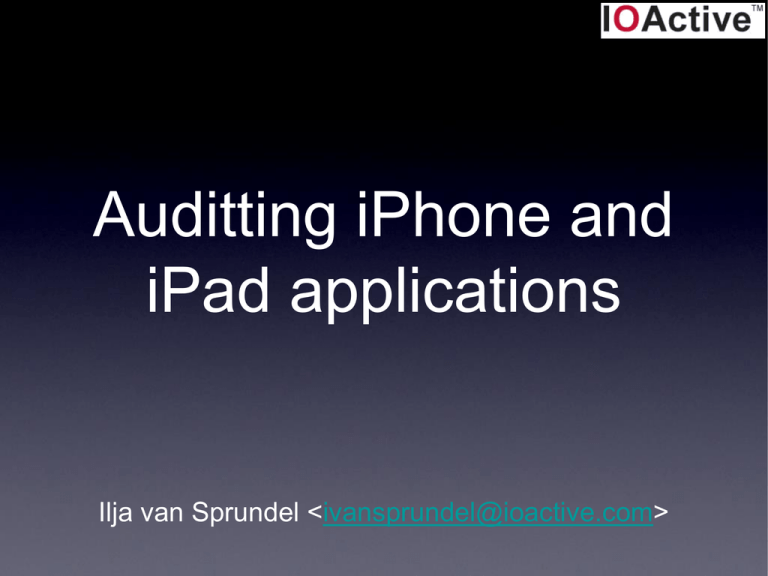iPhone and iPad Hacking
advertisement

Auditting iPhone and
iPad applications
Ilja van Sprundel <ivansprundel@ioactive.com>
Who am I?
• Ilja van Sprundel
• IOActive
• netric
• blogs.23.nu/ilja
•
•
What this talk is[n’t]
about
is:
•
•
•
common security issues seen in 3rd party iOS
applications
possible fix or mitigation of them
document how to exploit them in some cases
isn’t:
•
bugs in iOS itself
•
to some extend it does cover some api
shortcomings
Introduction
•
•
•
•
•
Mobile app market exploded over the last 2
years
lots of demand for security reviews of
iPhone and iPad apps over the last year or
so
Very little has been published
I’ve done a number of them in the last 10
months
notes of what I’ve learned so far
Application environment
• native applications
• iOS, port of MacOSX to arm cpu
• obj-c (strict c superset)
• obj-c classes take care of most low
level handling (memory allocations, ....)
Transport security
• fair amount of iOS apps need to do
secure transactions
• online banking, online trading, ...
• They will use SSL
• use of https:// urls passed to
NSURLRequest / NSURLConnection
• api uses a set of default ciphers:
Transport security
Transport security
• TLS_RSA_WITH_DES_CBC_SHA
• TLS_RSA_EXPORT_WITH_RC40_MD5
• TLS_RSA_EXPORT_WITH_DES40_CBC_
SHA
• TLS_DHE_RSA_WITH_DES_CBC_SHA
• TLS_DHE_RSA_EXPORT_WITH_DES40_
CBC_SHA
Transport security
• on by default
• no (documented) way to turn it off
• this is (kinda) documented:
from apple’s Secure Coding Guide (2010-02-12),
page 29
Transport security
• SSL api’s on iOS aren’t granular
enough
• developer should be able to set
ciphersuites
• can’t fix it, but you can mitigate it
• include an ssl library and use that one
(e.g. CyaSSL and MatrixSSL are build
for embedded use)
Transport security
• documentation said secure trasport
programming not available, use
CFNetwork
• CFNetwork doesn’t allow setting
ciphersuites (AFAIK)
• it does have api’s for some other things:
•
•
•
•
allow expired certs
allow expired roots
allow any root
don’t validate certificate chain
Transport security
NSMutableDictionary *settings = [[NSMutableDictionary alloc]
init];[settings setObject:[NSNumber numberWithBool:YES]
forKey:(NSString
*)kCFStreamSSLAllowsExpiredCertificates];[settings
setObject:[NSNumber numberWithBool:YES]
forKey:(NSString
*)kCFStreamSSLAllowsExpiredRoots];[settings
setObject:[NSNumber numberWithBool:YES]
forKey:(NSString *)kCFStreamSSLAllowsAnyRoot];[settings
setObject:[NSNumber numberWithBool:NO]
forKey:(NSString
*)kCFStreamSSLValidatesCertificateChain];CFReadStreamSe
tProperty((CFReadStreamRef)inputStream,
kCFStreamPropertySSLSettings,
(CFDictionaryRef)settings);CFWriteStreamSetProperty((CFWr
iteStreamRef)outputStream,
kCFStreamPropertySSLSettings, (CFDictionaryRef)settings);
Transport security
• Luckily none of that is on by default!
• takes quite some work to screw this up
for a developer
• however it’s not unthinkable: “wait, we
shipped that debug code ???”
url handler’s / IPC
• By design iPhone does not allow sharing
between applications
• application developers sometimes need
to share anyway
• developers (initially)found a way around
this
• This now appears to be supported by
apple (according to
developer.apple.com)
url handler’s / IPC
• Application can register a url handler
• other application would call url, with
data
• rather simple IPC mechanism
• http://mobileorchard.com/appleapproved-iphone-inter-processcommunication/
url handler’s / IPC
• info.plist file:
• code looks like:
- (BOOL)application:(UIApplication *)application
handleOpenURL:(NSURL *)url {
[viewController handleURL:url];
return YES;
}
url handler’s / IPC
• any webpage can call that link too
• any webpage can now also do IPC with
the application
• this IPC mechanism clearly had
unintended consequences
url handler’s / IPC
• so the browser can call the url handlers
too
• wouldn’t it be neat if we could get it
done without tricking a user into visiting
a webpage from their mobile safari ?
url handler’s / IPC
• iOS 3 (and beyond) has this neat wifi
hotspot feature
• if it connects to a wifi network, and
detects redirection, it assumes it’s a wifi
hotspot
• pops up mobile safari, and goes to the
redirected page
• see
http://support.apple.com/kb/HT3867
url handler’s / IPC
• looks like this:
url handler’s / IPC
• Attack is quite simple
• you must be on the same lan
• knock iOS device off the network
• when it rejoins, forge the redirect to
your webpage
url handler’s / IPC
• on by default
• you can turn it off (on iOS 4)
url handler’s / IPC
• Starting from iOS 4.2 there is newer api
that should be used
• application:openURL:sourceApplication:
annotation
• from the documentation:
url handler’s / IPC
• OpenURL is a much more elegant api
for IPC
• shows you who’s calling (so you can
reject the browser for example)
• allows passing of object instead of
serializing over url arguments
UIWebView
• can be used to build gui (mostly in weblike environments)
• basically renders html (can do
javascript!)
• a browser window more or less
UIWebView
• Vulnerable to attack (if used as a gui)
• if attacker can inject unescaped data
• will lead to Cross site scripting
UIWebView
•
•
•
•
by default there is no bridge from
UIWebView’s javascript to actual obj-c
most iOS apps developers that use
UIWebView (for gui’s) would like there to
be one
url handler, only valid for that specific
UIWebView
shouldStartLoadingWithRequest: method
UIWebView
• that url handler can do anything you
want it to do
• most UIWebView’s url handler are used
to handle some internals, arguments
are considered trusted!
• even worse, a lot of them
serialize/unserialize a methodname and
parameters !
UIWebView
UIWebView
• if used simply as a browser
• can do a lot more than render html and
interact with a webapplications
• can parse and render a large number of
file formats (and will not prompt user
first!)
UIWebView
•
•
•
•
•
•
•
•
•
•
•
Excel (xls)
keynote (.key.zip) (and also zip files)
numbers (.numbers.zip)
Pages (.pages.zip)
pdf (.pdf)
powerpoint (.ppt)
word (.doc)
rtf (.rtf) / rtf dictionary (.rtfd.zip)
keynote ’09 (.key)
numbers ’09 (.numbers)
pages ’09 (.pages)
UIWebView
•
•
•
•
•
•
Very long list
enormously difficult file formats to parse
once parsed it gets rendered
•
•
as html
in the current DOM
apple api’s, but they are in proc !
on by default
no way to turn this off
UIWebView
• does a number of other things:
• e.g. try to detect phone numbers and
turns them into tell:// url’s
• you can turn this off
• set detectPhoneNumbers property to
NO
UIWebView
• mitigation: render out of proc
• give url to safari instead of rendering in
UIWebView
• attack surface reduction
• if a bug gets exploited now, your
application is no longer affected.
UIImage
• Wide attack surface very similar to
UIWebView’s
• UIImage is a general image class
• can handle a _LOT_ of image file
formats
UIImage
•
•
•
•
•
•
•
•
tiff
jpeg
png
bmp
ico
cur
xbm
gif
UIImage
• not to mention some extensions that
work with various image file formats:
• exif
• ICC profiles
UIImage
• Huge attack surface
• there is no property to specify which
one you want and which you don’t want
UIImage
• 2 possible workaround
• UIImage allows using CGImageRef
• use more low-level Core Graphics
library to specifically load jpg or png
• then feed the CGImageRef to UIImage
UIImage
•
•
•
or you could just look at the first couple of bytes of the
image file
each graphics format is trivial to detect based on some
magic bytes in the begining
for example:
•
•
•
•
png signature: 137 80 78 71 13 10 26 10 (decimal)
jpg signature: 4A 46 49 46
GIF signature: 47 49 46 38 39 61 or 47 49 46 38 37 61
BMP: first 2 bytes: “BM”
header / xml injection
• not iOS specific, however rampant in
mobile apps
• mostly with regards to interacting with
webservices
• dev’s implement their own http handing
stuff
• forget things like escaping \r, \n, “, ...
header / xml injection
• Consider the following example:
- (NSData *)HTTPHdrData {
NSMutableString *metadataString = [NSMutableString string];
[metadataString appendString:@"Content-Disposition: form-data"];
if (self.name)
[metadataString appendFormat:@"; name=\"%@\"", self.name];
if (self.fileName)
[metadataString appendFormat:@"; filename=\"%@\"", self.fileName];
[metadataString appendString:@"\r\n"];
if (self.contentType)
[metadataString appendFormat:@"Content-Type: %@\r\n", self.contentType];
…
return result;
}
header / xml injection
•
•
•
•
iOS has some decent api’s for this
NSMutableURLRequest
•
•
addValue:forHTTPHeaderField
setValue:forHTTPHeaderField
not vulnerable to injection
although they do fail silently if injection is
detected
Format string bugs
•
•
•
•
iPhone apps use obj-c
which is native code
however, if you stick to the obj-c syntax
and the classes provided, chances of
overflows and the like are small (the
provided classes can do almost anything
you want)
provided classes also have format based
functions
Format string bugs
• these formatstring functions can also
lead to formatstring bugs
• seems most iOS apps are riddled with it
• most iOS apps developers don’t seem
to know this is a problem
Format string bugs
•
vulnerable obj-c methods
•
•
•
•
•
•
•
•
NSLog()
[NSString stringWithFormat:]
[NSString initWithFormat:]
[NSMutableString appendFormat:]
[NSAlert informativeTextWithFormat:]
[NSPredicate predicateWithFormat:]
[NSException format:]
NSRunAlertPanel
Format string bugs
•
•
obj-c is a superset of c
so all c fmt functions could also be
abused in iOS apps:
•
•
•
•
printf
snprintf
fprintf
...
Exploiting bugs
binary protocol
handling
•
•
•
•
said before
•
•
obj-c superset of c
stick to NS* objects, mostly safe
binary protocol handling is sort of the
exception
no good obj-c classes for that
developers have to fall back to old c-style
binary protocol parsing.
Directory traversal
• iOS has similar file api’s as MacOSX
• same types of desktop/server os file
issues
• NSFileManager
Directory traversal
• classic dir traversal:
NSString *file = [[NSString alloc] initWithFormat: @"%@/%@",
NSTemporaryDirectory(), attackerControlledString];
NSFileManager *m = [NSFileManager defaultManager];
[m createFileAtPath:text contents:nsd attributes:nil];
• ../../../../ will work.
•
Directory traversal
Poison NULL byte
NSString *file = [[NSString alloc] initWithFormat: @"%@/%@.ext",
NSTemporaryDirectory(), attackerControlledString];
NSFileManager *m = [NSFileManager defaultManager];
[m createFileAtPath:text contents:nsd attributes:nil];
•
•
../../../../blahblah\0
This works, because NSStrings don’t use 0bytes to terminate a string, but the iOS kernel
does.
NSXMLParser
• NSXMLParser is the class used to
parse xml files
• it handles DTD’s by default
• billion laughs
• no way to turn it off
• doesn’t resolve external entities by
default
• can be turned on
NSXMLParser
• There’s kindof a hairy workaround.
• 6 callbacks can be defined, that will be
called if a DTD is encountered.
•
•
•
•
•
•
foundElementDeclarationWithName
foundAttributeDeclarationWithName
foundInternalEntityDeclarationWithName
foundExternalEntityDeclarationWithName
foundNotationDeclarationWithName
foundUnparsedEntityDeclarationWithName
NSXMLParser
- (void) parser:(NSXMLParser*)parser foundExternalEntityDeclarationWithName:(NSString*)entityName {
[self
abort:@"DTD"]; } - (void) parser:(NSXMLParser*)parser foundAttributeDeclarationWithName:(NSString*)attributeName
... {
[self abort:@"DTD"]; } - (void) parser:(NSXMLParser*)parser
foundElementDeclarationWithName:(NSString*)elementName model:(NSString*)model {
[self abort:@"DTD"]; } (void) parser:(NSXMLParser*)parser foundInternalEntityDeclarationWithName:(NSString*)name value:(NSString*)value {
[self abort:@"DTD"]; } - (void) parser:(NSXMLParser*)parser
foundUnparsedEntityDeclarationWithName:(NSString*)name ... {
[self abort:@"DTD"]; } - (void)
parser:(NSXMLParser*)parser foundNotationDeclarationWithName:(NSString*)name publicID:(NSString*)publicID ... {
[self abort:@"DTD"]; }
NSXMLParser
• This works, but it’s hairy and error
prone
• it would be nice if NSXMLParser had a
parseDTD attribute
Questions ?








